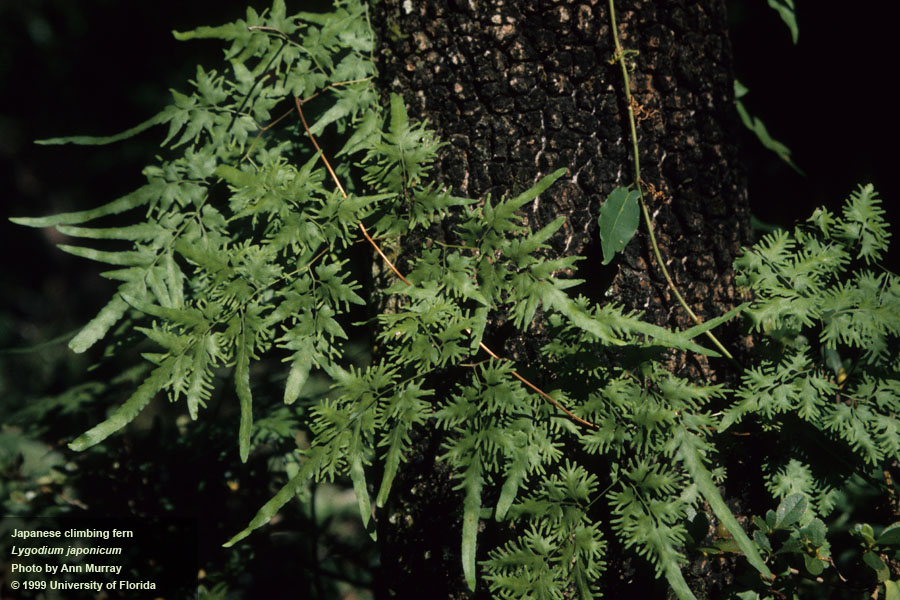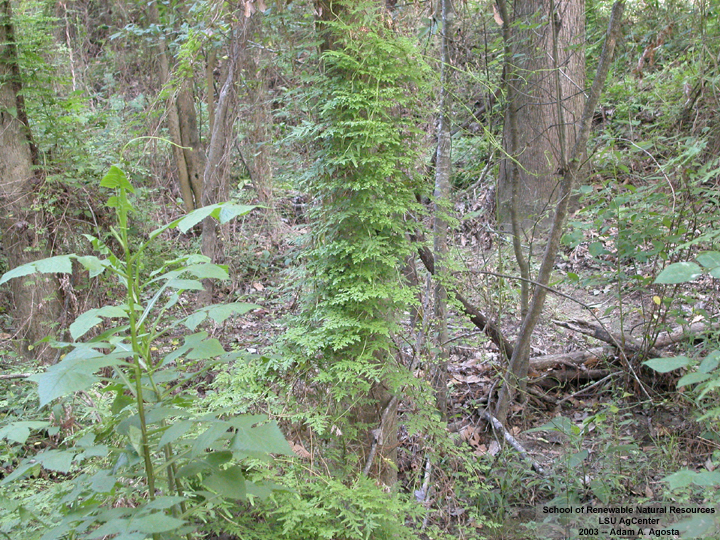Japanese climbing fern (Lygodium japonicum) is a perennial climbing fern native to East Asia. It was introduced to the southeastern U.S. as an ornamental in the early 1900s. Despite its attractive appearance, Japanese climbing fern is a Category I noxious weed (listed by the Florida Exotic Pest Plant Council) that is overtaking forests throughout the southeast. Even more troubling is the fact that once established, Japanese climbing fern is extremely difficult to control.
Biology and Identification
Japanese climbing fern has a vine-like growth pattern (actually a frond with a twining rachis) and can reach lengths of up to 90 ft. Fronds are feathery in appearance and have triangular, compound leaf branches that are opposite in arrangement. Leaflets are lobed and stalked. Leaves are light green and rachises are orange to brown. Rhizomes are below-ground and are black in color.

Reproduction can occur by spores and self-fertilization. Spores are numerous, long-lived, and easily spread. Their abundance increases through the growing season, with peak spore release in October. Leaf branches near the bottom of the vine-like growth are sterile, but fertility increases in successive leaf branches. As a result, self-fertilization is also more common as the growing season progresses. Spread also occurs vegetatively via the rhizomes. Rhizomes spread and re-sprout after winter frosts and fire.
Habitat
Japanese climbing fern is present throughout the southeastern U.S. with verified reports in Alabama, Arkansas, Florida, Georgia, Kentucky, Louisiana, Mississippi, North Carolina, Oklahoma, South Carolina, Tennessee, and Texas. It is also found in Hawaii. Japanese climbing fern can invade a wide variety of habitats, but has a preference for moist soils. It’s invaded forests, swamps, marshes, river and stream banks, pine plantations, pastures, roadsides, fence rows, and other natural and disturbed areas.
Threats of Invasion
Dense masses of Japanese climbing fern outcompete native plants and prevent native plant seeds from germinating. The climbing fern essentially suffocates the canopy and can drastically reduce light penetration to the forest floor, eliminating the understory. The increase in biomass due to dense masses of Japanese climbing fern also provides a fuel ladder that increases vulnerability of the forest canopy to fire, possibly increasing fire severity and compromising safety of prescribed burns.

Japanese climbing fern also poses an economic threat to commercial pine plantations, particularly those harvested for pine straw. Landowners use herbicides to control Japanese climbing fern, increasing operating costs. Transport of spores in pine straw is a major means of spread.
Control
There is no known effective biological control agent for Japanese climbing fern. Fire is also ineffective because the fern quickly regrows after being burned. Chemical control is the best means of controlling Japanese climbing fern. Products containing glyphosate and metsulfuron methyl are most effective and can be used in combination. Metsulfuron methyl is less damaging to surrounding native vegetation than glyphosate. Cutting or pulling vines and then applying herbicide to piles of vines can also help reduce damage to surrounding vegetation. When applying herbicide, it is important to use a surfactant to improve plant upstake. Herbicide application is most effective from July to October.
How can you help?
If you see Japanese climbing fern (or any other invasive species) be sure to report it using the Early Detection and Distribution Mapping System (EDDMapS) for invasive species. More information here.
If you are handling Japanese climbing fern, be careful not to contaminate new areas as spores spread easily. Be sure to bag any pulled vines before transport and wash any contaminated clothing.
 0
0
